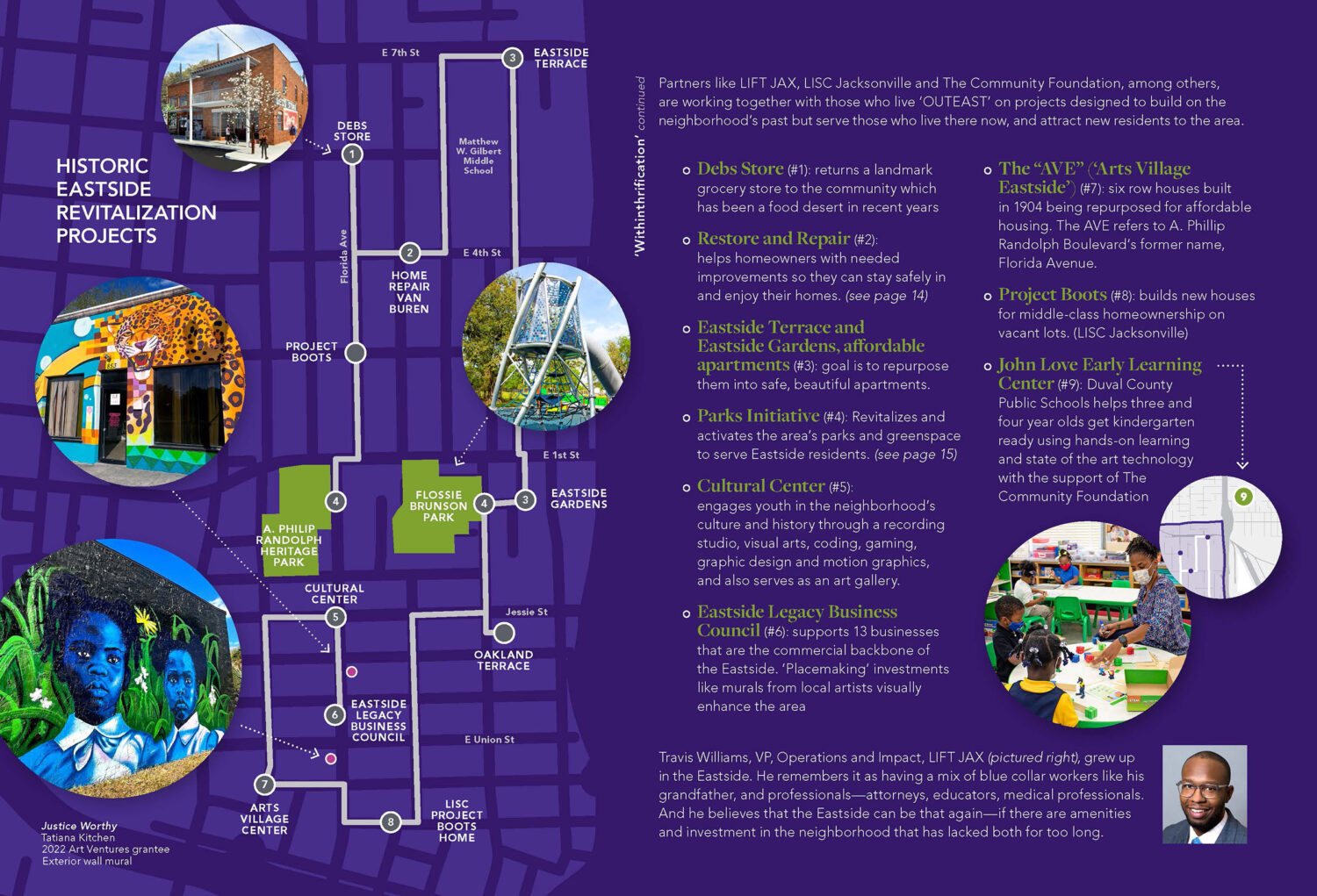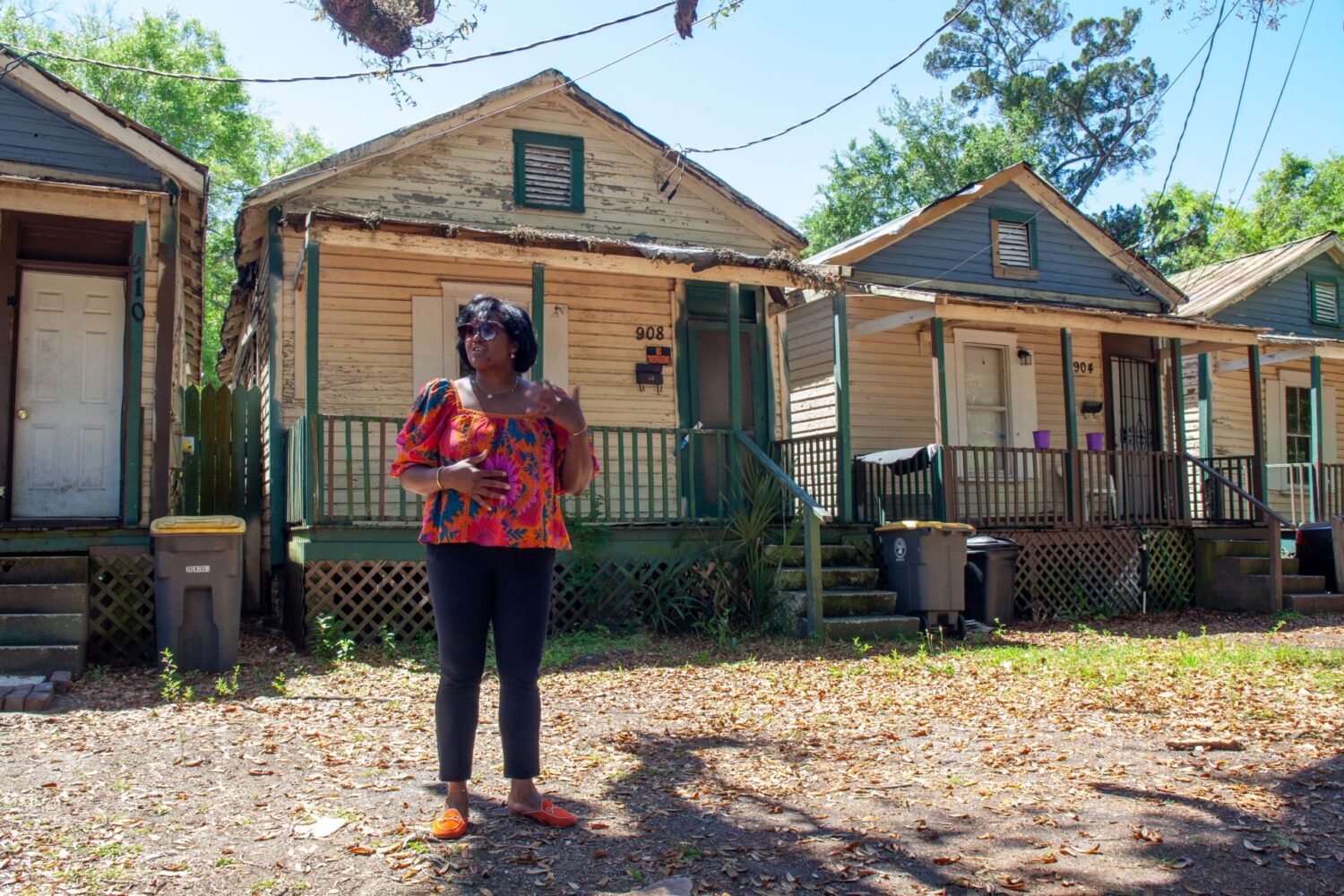The Community Foundation has worked to uplift neighborhoods for decades.
We helped bring the Local Initiatives Support Corporation (LISC) to Jacksonville more than 20 years ago, and continue to fund it annually.
We have made grants directly to numerous small and grassroots neighborhood organizations over the years. Several years ago, we increased TCF’s funding and support of organizations like LISC Jacksonville, LIFT JAX and the neighborhood Community Development Corporations, including the Historic Eastside CDC, to help them work alongside residents.
The work to revitalize the Historic Eastside from within shows the potential for inclusive development when done in support of local residents’ own vision for their neighborhood.
'Withintrification' of the Historic Eastside
"Most low-income residents feel that no one cares for them. Investing in the Eastside is really a LOVE LETTER to our community to say 'there is someone who cares about you and your family and the quality of life you deserve."
Suzanne Pickett, President and CEO of Historic Eastside Community Development Corporation
Jacksonville’s Historic Eastside—proud home of generations of African-American families—is being revitalized by hard working residents and partners who are determined to celebrate its history, chart its future and, most importantly, leave no one behind.
Bounded by the city’s expanding sports district, the Talleyrand Shipyards area and Historic Springfield, the East side has endured years of decline and underinvestment. But beneath its often dilapidated appearance, opportunities for improvement abound: scores of classic vernacular homes, significant parks and greenspace, and of course, proximity to exploding growth, as major investments in the Sports and Entertainment District come into focus.
Historic Eastside leaders see the potential, and are determined to maximize it without the displacement of current residents.
Suzanne Pickett, president and CEO of Historic Eastside Community Development Corporation (HECDC), calls this process ‘withintrification’—an alternative to gentrification that is driven from within, by residents. She has worked tirelessly to share the vision of a revitalized Eastside with partners and donors, and to bring a message of hope to the residents.
The Community Foundation has been proud to support her work through our Foundation-directed grantmaking, as well as making connections between her and interested donors, such as Linda Watkins, funded an internship position for the HECDC through the Catherine M. Drompp Charitable Fund.
Partners like LIFT JAX, LISC Jacksonville, and The Community Foundation, among others are working together with those who live ‘OUTEAST’ on projects designed to build on the neighborhood’s past but serve those who live there now, and attract new residents to the area.
LIFT JAX grew out of conversations held in 2017 among a group of Jacksonville’s business and community leaders, including TCF, who were focused on eliminating poverty in the city.
The Community Foundation gave LIFT JAX a two year, $100,000 grant for initial start-up operational support in 2020-2021, and made an additional grant to support a LIFT JAX with a STEM education program at John Love Early Learning Center, opened by Duval County Public Schools in the Eastside.
“TCF had a long-term focus on neighborhood revitalization, so they immediately recognized the potential for partnership and have been an essential part of our success,” said David Garfunkel, president of LIFT JAX.
Block by Block Revitalization

- Debs Store (#1): returns a landmark grocery store to the community which has been a food desert in recent years.
- Restore and Repair (#2): helps homeowners with needed improvements so they can stay safely in and enjoy their homes.
- Eastside Terrace and Eastside Gardens, affordable apartments (#3): goal is to repurpose them into safe beautiful apartments.
- Parks Initiative (#4): Revitalizes and activates the area’s parks and greenspace to serve Eastside residents.
- Cultural Center (#5): engages youth in the neighborhood’s culture and history through a recording studio, visual arts, coding, gaming, graphic design and motion graphics, and also serves as an art gallery.
- Eastside Legacy Business Council (#6): supports 13 businesses that are the commercial backbone of the Eastsdie. ‘Placemaking’ investments like murals from local artists visually enhance the area.
- The “AVE” (‘Arts Village Eastside’)(#7): six row houses built in 1904 being repurposed for affordable housing. The AVE refers to A. Phillip Randolph Boulevard’s former name, Florida Ave.
- Project Boots (#8): builds new houses for middle-class homeownership on vacant lots. (LISC Jacksonville)
- John Love Early Learning Center (#9): Duval County Public Schools helps three and four year olds get kindergarten ready using hands-on learning and state of the art technology with the support of The Community Foundation.
Travis Williams, VP, Operations and Impact, LIFT JAX, grew up in the Eastside. He remembers it as having a mix of blue collar workers like his grandfather, and professionals—attorneys, educators, medical professionals. And he believes that the Eastside can be that again—if there are amenities and investment in the neighborhood that ahs lacked both for too long.
“Our goal is to support community leaders and residents in what’s important to them — whether it’s housing, bringing back a grocery store, or park development. We want to make strategic investments here so that this is a neighborhood of choice,” said Travis Williams, VP of Operations and Impact at LIFT JAX.
Repairing Homes with the Support of Delores Barr Weaver
Restore and Repair is one of the Eastside’s signature efforts.
Its goal is to help longtime residents with limited financial means make improvements
to their homes to ensure their safety and improve livability. The improvements also
help homeowners preserve generational wealth. The Historic Eastside CDC, LIFT JAX
and LISC Jacksonville are spearheading the project, which can include replacing roofs,
HVAC systems, flooring, facades and paint.
Restore and Repair’s original goal was to improve 20 homes, one-by-one. Then,
philanthropist Delores Barr Weaver worked with The Community Foundation staff on
a concept of creating a model block – one where the homes were improved, and funds
were available for beautification of the area, as well as the historic church in its midst.
Through her Delores Barr Weaver Legacy Fund, she sought to improve an entire model block so that the community could see what it might look like when the vision was fulfilled.
“(Suzanne’s) passion for this project, and her commitment to help these longtime homeowners, was compelling,” Weaver said.
So far, 10 out of 14 houses on Van Buren street have been repaired, and the goal is to repair 50 homes across the entire neighborhood.
